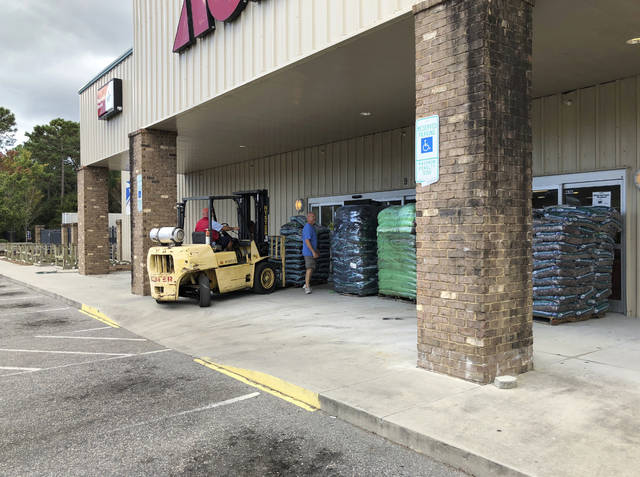Ace is the place before and after a storm

ASSOCIATED PRESS
Manager Tom Roberts watches as an employee positions a pallet of mulch to protect the Ace Hardware store from Hurricane Florence in Calabash, N.C., on Sept. 12.
MIAMI >> Before and after a hurricane, Ace is the place. And Home Depot and Lowe’s. And many other hardware and building supply outlets.
Not surprisingly, these companies plan for storms such as Hurricane Florence all year. Much like the Federal Emergency Management Agency, supplies are pre-positioned and trucks loaded and ready to go with everything from batteries to gas cans to tarps to chainsaws.
Here’s the thing: the government can only do so much. Most people must fend for themselves at some point, and the local hardware or building supply store is where they go. Not everything is available easily online. Try to buy some drywall that way.
“It’s a year-round thing for us,” said Margaret Smith, spokeswoman for Atlanta-based Home Depot. “When it’s hurricane season, we are operating 24 hours a day.”
As Florence bore down on the Southeast coast this week, Ace Hardware manager Tom Roberts watched as an employee finished five of the busiest days they have ever seen in their store in the tiny village of Calabash, North Carolina.
They sold hundreds of gas cans and ran out of generators, but still had bottled water, sand bags and other items, Roberts said.
Don't miss out on what's happening!
Stay in touch with breaking news, as it happens, conveniently in your email inbox. It's FREE!
“We’re going to be just as busy with clean up once this thing is gone,” he said.
Home Depot and Mooresville, North Carolina-based Lowe’s, the two biggest home supply companies, both activated sophisticated emergency command centers that bring together various divisions to work on everything from shipping logistics to ensuring employees in hurricane zones get back on their feet. They have their own meteorologists on duty and are in contact with government agencies.
The key is making sure the right supplies are ready at the right time, said Jennifer Thayer, Lowe’s vice president for store operations in North and South Carolina. For example, people might need more gas cans and plywood before a hurricane and more wet/dry vacuum cleaners or tarps for damaged roofs after the storm, she said.
And wind is one thing, while flooding is another in terms of what customers need.
“We plan it out pre-storm. And then we start shifting into post-storm,” Thayer said. “We have the ability to put merchandise strategically in the stores. It depends on the event.”
Smith said Home Depot has about 1,100 trucks loaded and ready to respond to its stores in the Carolinas and Georgia once Florence passes through. Lowe’s says on its website it has shipped some 2,700 truckloads of supplies to the area threatened by Florence.
Both companies plan to open stores in the storm zone as soon as possible.
“Our communities count on us in storm prep and then recovery in a very big way,” Smith said.
Many of these chains can also bring in employees from other regions to substitute for those in storm-stricken areas, giving them time to deal with their own personal home damage or other issues from a storm. Sometimes the local workers can get financial assistance.
For example, Smith said Home Depot will often provide grants to help pay for hotels or to fill gaps in insurance coverage for damage to an employee’s home. Thayer said Lowe’s has an employee relief fund for such circumstances.
“People can request funds to help them if they can’t afford to get back on their feet,” Thayer said.
In 2017, Home Depot had revenue of more than $100 billion. Lowe’s earned about $68 billion. Sales of hurricane-related materials spike before and after storms, but the profit is beside the point, Thayer said.
“At the end of the day, it’s about the community, it’s about the stores,” she said.



